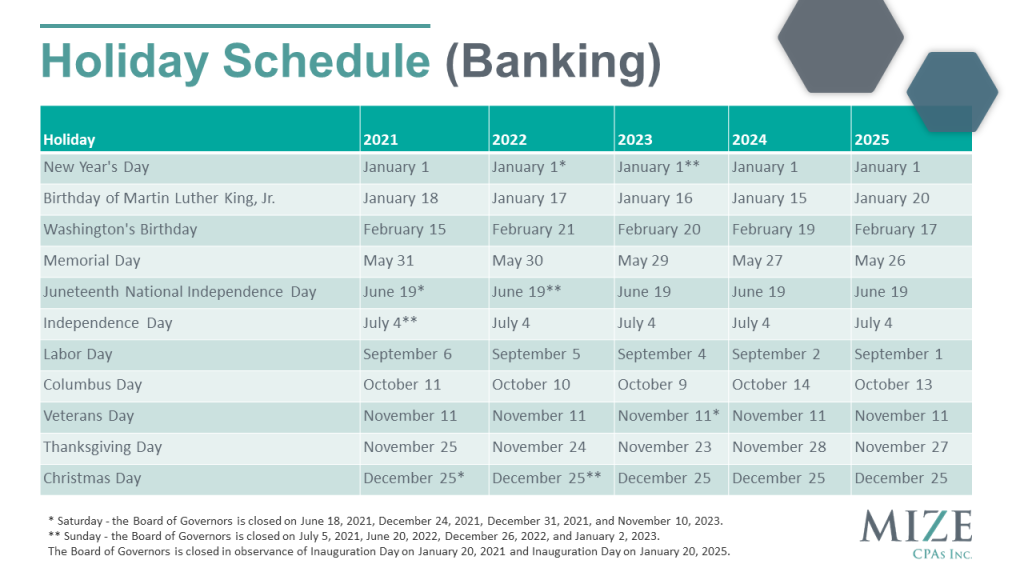PDF DOWNLOADS: 2021 Payroll Year-End Checklist and 2022 Employee Benefit Plan Limits Summary
As we all know payroll is a constantly evolving environment with new laws and regulations passed every year. If an organization does not stay compliant, they could be subject to penalties and lawsuits. Today we will be covering payroll compliance updates along with new and upcoming regulations that could potentially affect your organization and your individual employees.
ACA Refresher
We will begin with a quick refresher of the Affordable Care Act or ACA. The Affordable Care Act states that if an organization employs fifty or more full-time equivalent employees in a calendar year, they must provide affordable health care coverage for eligible employees. An employee is eligible, if they are employed on average, per month, for at least 30 hours of service per week or at least 130 hours of service in a calendar month.
ACA Changes
For the health care coverage provided to be affordable, you as the employer may not charge the employee more than the yearly safe harbor of their W2 wages for single coverage. The IRS sets the yearly safe harbor rate and has decreased it to 9.61% for 2022 from the prior rate of 9.83%.
As you may know there are penalties for not being compliant with ACA regulations. Not only can you be penalized for not offering health care coverage, but you may also be penalized for offering unaffordable health care coverage. In 2022 a penalty of $2,750 per full-time employee will be incurred if an employer fails to offer minimum essential coverage to 95% of its full-time employees.
However, these penalties can be an interesting discussion for employers. For example, if you as an employer have a significant health care cost increase of say 15% for 100-200 employees, it may be cheaper for you to consider the penalty rather than keeping the employee medical premiums unnaturally low.
Form 1095’s must be processed by January 31st for the 2021 coverage year.
COVID-19 Sick Leave
Now let’s switch gears and discuss legislation that extended COVID-19 sick leave.
The Healthy Families and Workplaces Act, which pertains to virtually all private employers in Colorado, regardless of size, mandates that an employer must provide up to 80 hours of paid sick leave to employees for COVID-19 related absences. This is in accordance with the provisions of the federal Families First Coronavirus Response Act or FFCRA. This requirement is presently in effect and will remain in effect until December 31, unless continued by additional legislation.
The city of Oakland, California also passed legislature extending their mandatory COVID-19 sick leave until 12/31/21. Be aware though that when Oakland extended the ordinance, employers are not required to refill the sick leave banks. So, if an employee used all his or her COVID sick leave they will not receive any more, rather just be able to use their remaining balances.
Employee Retention Tax Credit
The Employee Retention Tax Credit was included in the American Rescue Plan Act of 2021.The ERTC is a refundable tax credit against certain employment taxes equal to 50%-70% of the qualified wages an eligible employer paid to employees after March 12th, 2020, through September 31 of this year. Keep in mind that since it did expire as of September 31st, you will not be able to claim any of the credit for fourth quarter of this year. But, if you did not claim for prior quarters credits and you are eligible to claim the ERTC, you can still file amended form 941’s to get the funds. There are other requirements tied to headcount and government restrictions to be eligible, but it is certainly worth investigating if you have not already done so. If you have questions regarding eligibility for the Employee Retention Tax Credits reach out and speak with your Mize relationship manager.
Non-Discretionary Bonus Overtime
The Fair Labor Standards Act or FLSA requires that bonuses paid to non-exempt employees for attendance, production, quality, or other work incentive bonuses be included in the employees’ regular rate for purposes of calculating overtime. For a bonus to be “discretionary” the employer must retain discretion as to both the fact that a bonus will be paid and the amount of the bonus until at or near the end of the period for which the bonus is paid. Examples of “discretionary” bonuses would be holiday, anniversary, or birthday bonuses. If a bonus is non-discretionary, the bonus was earned when and where the employee worked the overtime. If Mize provides your payroll services, we are calculating non-discretionary bonus overtime on your behalf to keep you compliant with this FLSA regulation.
Hiring and Retention
Offering benefits such as 401K and health insurance coverage are always a great start. The health and retirement of your staff are always a worthwhile investment in your business. Mize is integrated and we collaborate with several providers in both spaces and are always happy to discuss options with our clients.
Providing additional ways of pay to your employees is becoming extremely popular as well. Whether that is through the option of direct deposits, pay cards, and even early wages access using pay on demand tools. These tools have shown to increase retention and provide operational relief to employers. Especially those who have a high number of employees waiting for checks by mail that could be disrupted by the pandemic or natural disasters. Along those same lines, multiple states assess fines and penalties for paying employees late. Mize is currently integrated with 3 or 4 of these types of providers and have found that they are low maintenance while still providing a great benefit to employees.
Another employer trend on the rise is contracting with an onboarding company. These companies offer new hire onboarding which reduces the amount of time and effort spent on getting the tedious paperwork completed to keep you compliant with federal and state laws. They also keep records in an electronic format, reducing the amount of paperwork you must store in your office. These companies also provide services that help you stay compliant with the Affordable Care Act requirements such as making your insurance offers and recording acceptance and declination dates for newly eligible employees and during that busy open enrollment period that we all dread.
Preparing for Year-end
For many people, year-end means gatherings with family and friends, but for those of us who process payroll, year-end means a lot of work as well. You have your standard payroll processes, potentially some additional bonus payouts and you also have the year-end reporting in the form of W-2s and 1095’s.
Here are some items to think about now to ensure that you have a smooth transition into 2022.
- This is the time to make sure that all outstanding manual checks written are applied to employee wages and all checks that need to be voided have been taken care of. This will ensure that all W2 wages are correct and minimize the chance that you will need to amend previous quarterly reporting and issue corrected W2’s.
- Bonuses are common during the end of the year. Whether it be performance based or for the holidays they need to be included in the employee’s taxable income.
- Holiday gifts, whether it be cash or gift cards, need to be reported as wages and added to W2 wages.
- Remember to address any executive compensation that is taxable such as health and life insurance and any other fringe benefits like vehicle usage or profit-sharing.
Once you have entered all your year-end items you will be ready to print and distribute your employees W2’s and 1095’s. There are strict deadlines for distributing these to employees and reporting them to the IRS. Failure to submit in a timely manner holds you open to costly penalties. The deadline for submitting both W2’s and 1095’s is January 31st.
Annual Limit Adjustments
Another important item to think about at year end is any specific limit increases that will occur and may affect your organization. Here we will cover the most common limits that payroll professionals deal with.
- Social Security
- Increases to 147,00
- 401K Contribution
- Remains at 20,500
- 401K Catch-up Contribution
- Remains at 6,500
- IRA – Roth & Traditional
- Remains at 6,000
- IRA Catch up
- Remains at 1,000
- Simple IRA
- Increases to 14,000
- Simple IRA Catch up
- Remains at 3,000
- HSA – Health Savings Account
- Increase to 3,650 for self-coverage under HDHP
- Increase to 7,300 for family-coverage under HDHP
- HSA Catch up
- Remains at 1,000
- FSA – Flex Spending Account
- Increases to 2,850
- Highly Compensated Employee
- Increases to 135,000
- Mileage Rate
- Will not be announced until Mid-December
Holiday Schedule (Banking)
Now let’s briefly discuss a common and well-known payroll hurdle, holidays. The thought of an upcoming holiday is a sigh of relief in most industries but as you have more than likely experienced, payroll is not one of them. Completing payroll accurately and on time can be stressful under normal circumstances but on weeks where a holiday falls, your timeline diminishes. Not only does the workload not diminish with the timeline, but it also generally creates additional items that need to be added to payroll such as holiday pay. The Federal Reserve identifies eleven annual holidays where the banking sector is closed for ACH and wire transactions. If you have a payroll deadline that falls on or close to one of these, you will need to think about what affect that has on your processing timeline. This could include changing your payroll check date all together and/or being required to submit payroll early to accommodate ACH and wire transfer cutoff times.
This schedule was taken from federalreserve.gov on November 10, 2021. Please click the image above to see the latest version.
Ok, that’s where we will stop for the day. I would like to thank you for your time and please let us know if you have any questions.

